How do you keep up with the soaring demand for video content without draining your budget, time, or team? Organizations are under growing pressure to deliver high-impact, scalable video, often in multiple languages and across various platforms. Video continues to be one of the most powerful tools for communicating complex ideas, building emotional resonance, and educating diverse audiences.
Yet traditional video production presents limitations: it’s slow, costly, and talent-dependent. Projects can take weeks to complete, require large cross-functional teams, and demand significant financial investment at every stage. These challenges can prevent companies from producing the volume and variety of content their audiences expect.
That’s where AI-powered video production is changing the game and offers a future-ready solution for modern teams. Whether you need to scale internal training, enhance marketing reach, or connect with a global workforce, AI video tools provide unmatched efficiency, flexibility, and impact.
Let’s explore the data behind the shift.
Lights, Camera, Conversion: Why Visual Content Rules in 2025
Imagine this: you’re trying to explain a complex idea to your team, launch a new product, or get a potential customer to care — and you’ve got about a few seconds to make an impression. What do you do? You hit play.
That’s exactly what businesses are doing, and the results speak for themselves. Video content delivers a 95% retention rate, compared to just 10% for text. It’s not just more effective; it’s transformative.
Employees are more engaged when they can see the message, not just read it. The impact reaches far beyond internal teams. Learning becomes easier when knowledge is delivered in motion, clear, concise, and memorable. It’s the same story with customers who are more likely to buy when they watch a story unfold. 87% of consumers have been convinced to make a purchase after watching a video. That’s how powerful visual storytelling can be.
Everything suggests one clear truth: visual content, especially video, dominates the most effective marketing methods today. Whether for education, promotion, or building connections, video has become the most powerful way to communicate. It’s quicker, more engaging, and easier to retain.
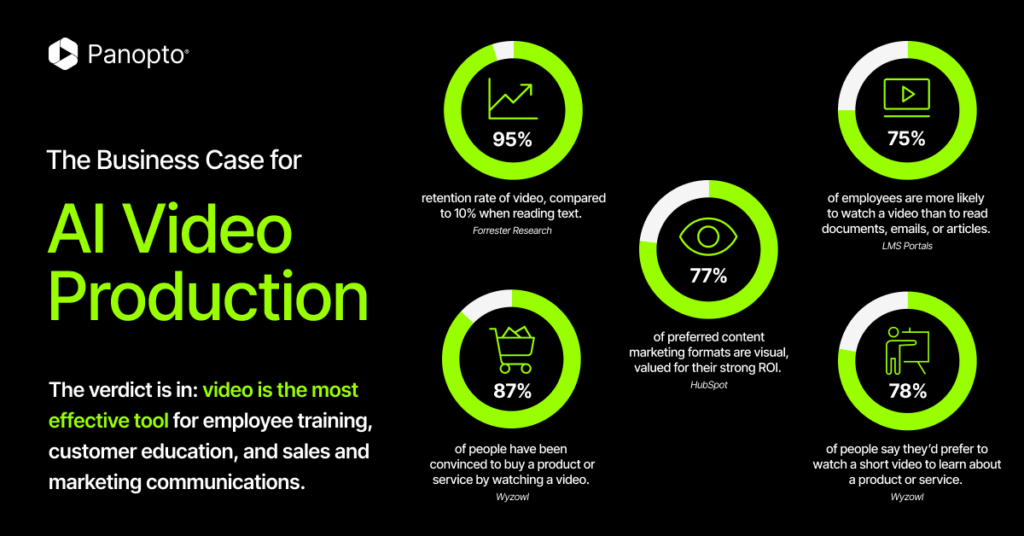
The Hidden Price Tag of Traditional Corporate Video Production
Video is an incredibly effective communication tool, but producing it the traditional way can come with a substantial investment. Even a one-minute corporate video involves multiple phases, each with its costs and considerations.
Let’s break it down:
Pre-production (scripting, storyboarding, location scouting, talent) can cost up to $6,300
Production (filming with a director, camera crew, assistant crew) ranges from $1,900 to $12,200
Post-production (editing, motion graphics, voiceovers, color correction) tacks on another $2,600 to $10,750
That puts your final price anywhere between $6,300 and $29,250 for just one minute of finished content. And for large-scale or highly polished video campaigns, those costs can easily soar past $50,000.
For companies looking to produce content consistently across teams, departments, and regions, this pricing model is simply unsustainable. So in today’s fast-paced digital world, waiting weeks and investing thousands into every video can hold back your marketing, training, and communication efforts.
The question isn’t whether video is valuable (it is) — the real question is: Can you afford to produce it the old way?
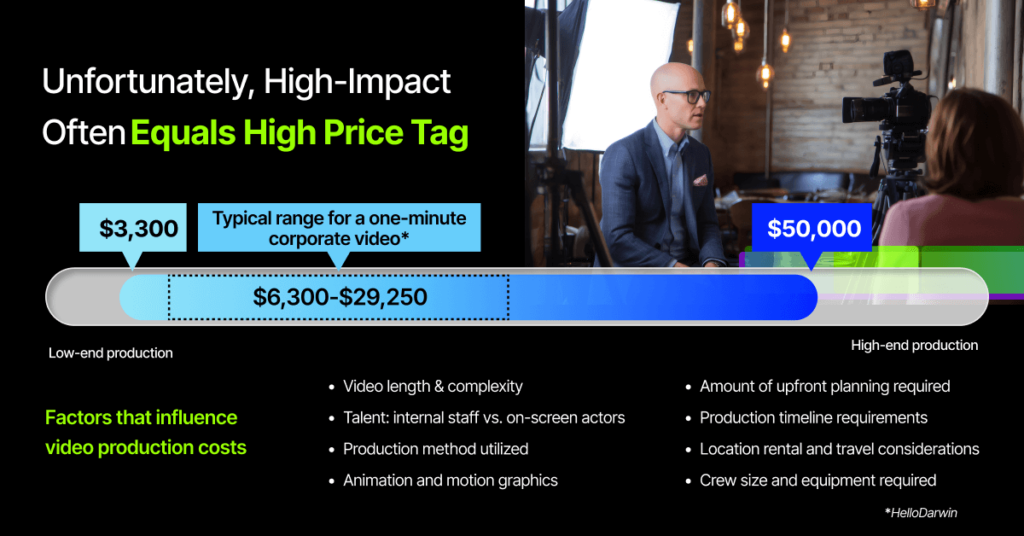
Specialized Skills: The Many Hands Behind Every Great Video
Creating high-quality corporate videos is a true team effort. Behind every polished clip are a number of talented professionals, each contributing their unique skills. From directors and producers to motion graphics artists, video editors, sound engineers, and camera operators, video production requires diverse expertise, often more than one person can provide alone.
Each role brings value, but also its own cost. Hourly rates for these specialists can vary depending on experience and location. When you multiply that across multiple team members and multiple stages: pre-production, production, and post-production — it’s easy to see how expenses can climb quickly.
Beyond cost, coordinating all these contributors adds time and complexity. Managing schedules, revisions, approvals, and consistency across roles often becomes a project. For organizations trying to scale content production or respond quickly to new needs, this traditional model can be limiting. That’s why many teams are beginning to explore AI-powered alternatives that streamline workflows, reduce overhead, and make it easier to create video at the speed of business.
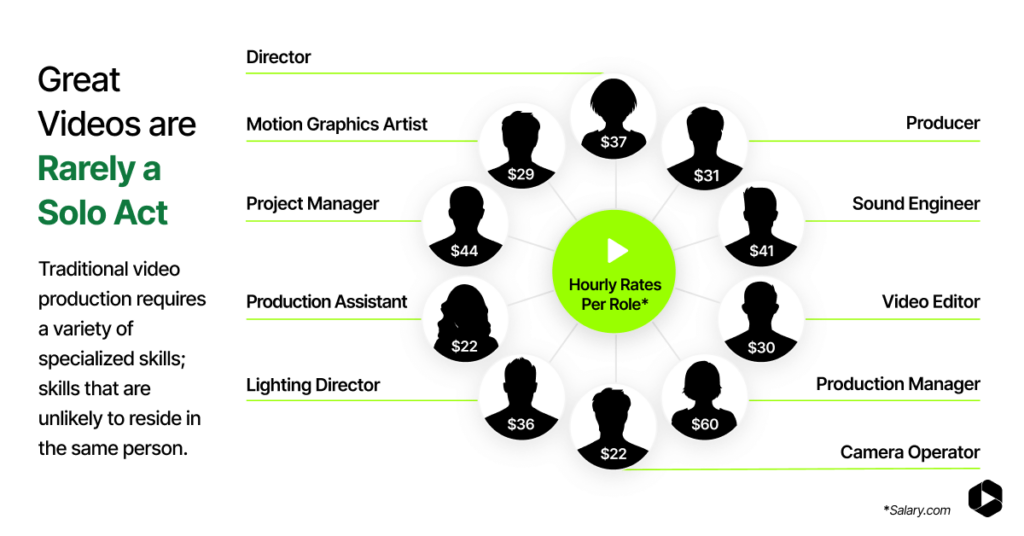
Why Traditional Video Production Takes Time?
Creating high-quality corporate videos involves many steps, each taking time. From brainstorming and scripting to filming and editing, every phase requires careful attention, collaboration, and approvals. Because of this, a typical video project can take 6 to 8 weeks or more to complete.
Pre-production might take up to four weeks as teams develop scripts, coordinate schedules, and finalize creative details. Filming often requires at least a week, depending on locations and availability, while post-production (editing, adding voiceovers, and final reviews) can take an additional two to three weeks.
While this timeline suits projects where quality and detail are priorities, it can feel lengthy when organizations need to produce video content more frequently or respond quickly to new opportunities. Understanding the natural rhythm of traditional video production helps teams plan effectively and identify where AI video solutions can speed up the process without compromising quality.
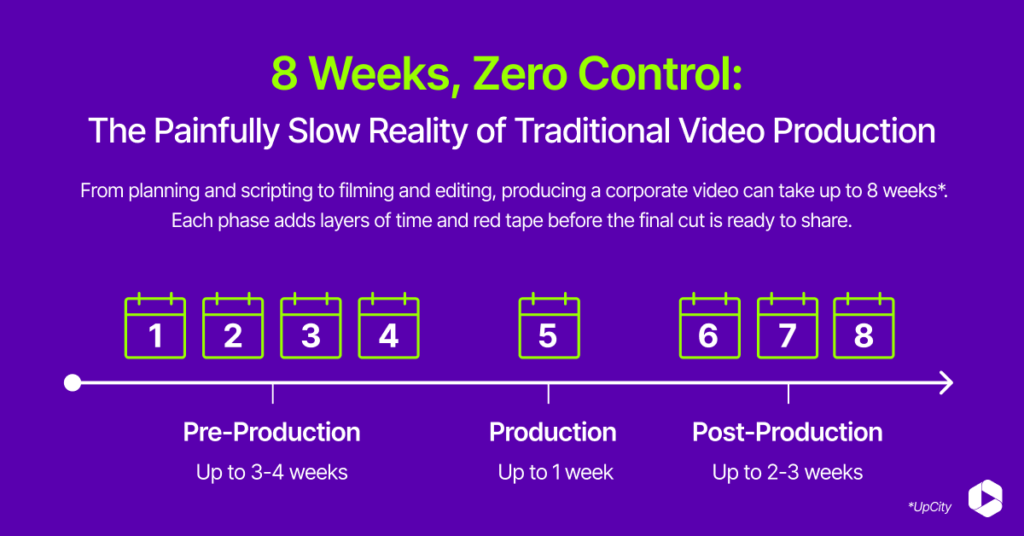
Navigating the Complexities of Video Localization
You’ve invested time, creativity, and budget into producing a standout video — now it’s time to share it with the world. But reaching a global audience means more than just uploading your video online. Localization is key to ensuring your message resonates across languages and cultures.
Localization involves more than simple translation; it includes adapting scripts for different regions, hiring voiceover artists, and synchronizing audio to match the visuals. Costs can add up quickly, with translation charged per word and voice dubbing billed per minute of video. Whether converting English to Spanish, German, Japanese, or any other language, this step often matches the original production in complexity and expense.
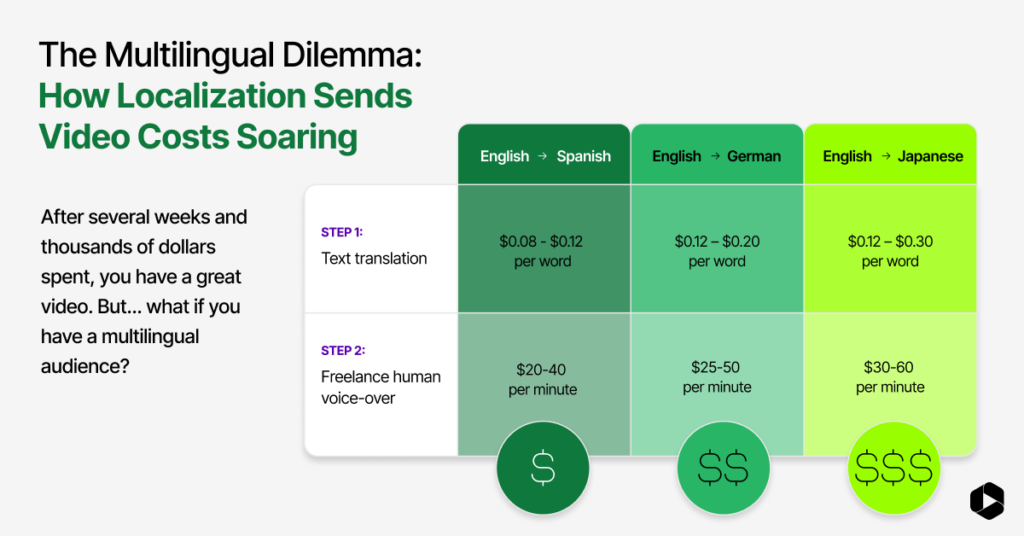
Have You Met Elai: Your AI-Powered Video Studio
What if you could create professional, studio-quality videos without the hassle of cameras, lights, or production crews? That’s where Elai, powered by Panopto, comes in — an AI-powered video creation platform designed to simplify the process and make video accessible for everyone.
With Elai, the days of waiting weeks and juggling expensive resources are over. You can produce polished, brand-aligned videos in minutes, not months. Whether you’re crafting product explainers, employee training modules, or internal communications, Elai’s intuitive tools empower you to create compelling video content that truly connects:
– 80+ AI talking avatars, including conversational “Listening Avatars”
– Auto-translation into 75+ languages with 400+ realistic voices
– Text prompt, PDF, PPT, URL, or text into video conversion
– Custom Avatars and AI voice cloning in 30+ languages
– Brand kit integration
– Create interactive videos with quizzes, buttons, and branching
– Use pre-built or custom templates for quick video creation with a collaboration option
– Automate video generation and scalability
Say goodbye to production delays and hello to a new era of video content creation!
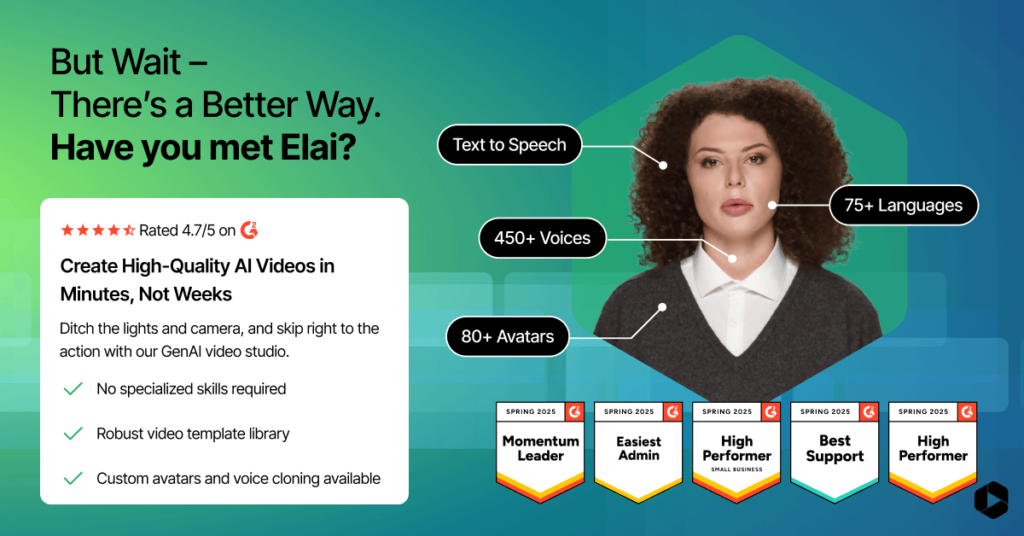
A Smarter Approach to Scalable Video Production
As video becomes a key tool for communication, education, and training, organizations seek faster, more flexible ways to create high-quality content. AI-powered platforms like Elai offer an innovative path forward, making it easier to scale video production, localize for global audiences, and easily add interactive elements.
This side-by-side comparison shows how Elai helps streamline the process: with a low monthly fee, video creation in just hours, instant localization in over 75 languages, built-in avatars for presenters, and interactive features like quizzes — all without the need for extensive resources or external tools.
By combining speed, scale, and smart automation, Elai empowers teams to deliver high-quality video content easily, keeping you ahead in a rapidly evolving digital world.

Final Thoughts
The way we communicate is evolving, and video stands at the forefront of this transformation. As audiences crave faster, more explicit, and more engaging content, organizations face the exciting challenge of meeting these expectations with agility and creativity. Traditional video production has been a reliable method, but the future belongs to solutions that unlock speed, scale, and accessibility, without compromising quality.
AI-powered platforms like Elai open the door to a new era of video creation, where compelling stories can be told quickly, in multiple languages, and with personalized touches that resonate worldwide. This isn’t just about technology — it’s about empowering teams to connect more meaningfully and confidently in a dynamic digital world.
Are you ready to rethink how video can work for you and lead your communication into the future?
